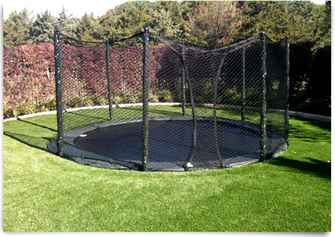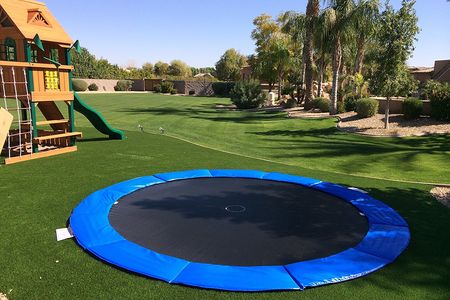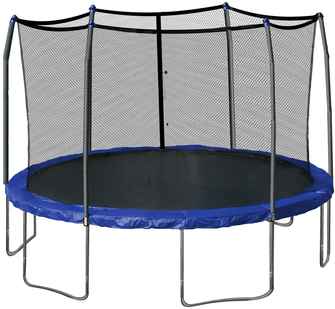In Ground Trampoline – The Cost and How To Install

Do you want a trampoline but are concerned about how it will look in your yard, or maybe the look of the trampoline isn’t your concerned, but instead it is how to mow around it? Well there is a new trend going around where you put the trampoline in the ground.
An in-ground trampoline is like an in-ground pool. You dig a hole, add a retaining wall, and make sure it has proper ventilation and drainage. Then you just stick the frame into the ground. You can make any type of trampoline an in-ground trampoline. It doesn’t matter if you want a round trampoline, a square trampoline, or a rectangle trampoline; you just got to dig the right shape hole.
Introducing The BERG Inground Trampoline
- Large 14 ft jumping surface for big jumps
- UV Resistant PVC padding that will last for years
- Less air resistance for higher jumps
In Ground Trampoline Kit For Sale
There are some in ground trampoline products in the market to make the job easier. We researched most of them and selected only the best ones.
In-Ground Trampoline Standard
Consider the In-Ground Trampoline Standard from In-Ground Trampolines.
- Pre-engineered In-Ground Trampoline
- Made in the USA
- Great quality and performance
- 12' and 15' inground trampoline sizes
- Super heavy-duty frame
- Easier installation procedure
10 ft x 7.5 ft In-ground Rectangular Trampoline
Also consider the 10ft x 7.5ft In-ground Rectangular Trampoline with patented safety net cable wire enclosure system.
- European Design Trampoline.
- Rectangular shape offers a higher jump and space, perfect for gymnasts.
- Frame has solid 16 gauge x 1.75" galvanized Steel Frame.
- Easy to place in most yards.
- Weight limit is 220 lbs
- Enclosure system for safety.
Read more about in ground trampoline retaining wall kits here.
In-ground Trampoline vs Above Ground
There are some advantages and disadvantages when comparing in-ground trampolines vs above ground trampolines like the looks, can you move it around, how easy it is to go in and out. We'll check some in ground trampoline benefits below.

In Ground Trampoline Advantages
- Looks great: The most obvious advantage to an in-ground trampoline is the look. The jumping surface is flush with the surface of the yard, and you can design all your yards landscaping around the trampoline. You can build an attractive retaining wall to keep the dirt from falling back into the whole, and you can install drainage pipes to move the water to where you want it. If you have a garden or water pound in your yard, than you can set the pipes up to drain the water to that location. This kills two birds with one stone ensuring the pond is feed with water or that your garden is watered. With landscaping you can even set up chairs or a seating area around the trampoline. His is nice because when the kids jump the adults can sit and talk.
- Easy to get in and out: Another big advantage is that it is easier to get onto an in-ground trampoline. No longer is the jumping surface three or more feet off the ground. Instead you can just walk right onto the trampoline. This makes it a lot easier for kids to get onto the trampoline. Now this does lead to a misconception. People thing in-ground trampolines are safer than above ground ones, but this isn’t one hundred percent true. You need a gap of around a half a foot between the retaining wall and the jumping surface to assure proper airflow. This means a kid could fall between it or fall on it. That is why it is a good idea to still have a safety enclosure on your in-ground trampoline. One aspect that in-ground trampolines are a lot safer in though is stability.
- Doesn't tip: An in-ground trampoline is anchored to the ground and there is no way for it to tip.
In Ground Trampoline Disadvantages
- The cost: The biggest disadvantage of an in-ground trampoline is cost. You have to ensure proper airflow and draining, so you get a proper bounce and so the frame will last as long as possible. Also, it is costly because you got to dig a hole big enough to fit the trampoline into, and building a retaining wall can be expensive. The cost can however be offset some if you are a hand person or a do it yourselfer.
- Unable to move: A final disadvantage is moving it. You may no longer have to move the trampoline to mow the grass, since there is no grass, but if you end up moving and want to take the trampoline with you, than you have to remove the trampoline and repair the hole. Also, if you decide you want the trampoline in a different spot, or a different model trampoline, than it can get to be a lot of work quickly to remove the current one and move it or put in a new one. If you are going to be living in the same place for a while though, and looks matter to you, than an in-ground trampoline may be a good option.
- Not as bouncy: If the ventilation is not done properly, the in-ground trampoline will not feel as bouncy and comfortable as the above ground. Remember to leave a large clearance for the air to flow.
Read our sunken trampoline problems guide for other disadvantages.
In-ground Trampoline Safety: Are Trampolines Safer In The Ground?
The logical answer would be yes. The closer you are to ground the safest. But that doesn't mean you don't need a safety net to be safe. So, are in ground trampolines safe? Click the link to read more about in-ground trampolines safety.
In-ground Trampoline Dangers
There are a few in-ground trampoline dangers The jumper can get hurt as bad in the in-ground as the above ground. The height difference is not that big. But sunken trampoline problems don't end there.
Another issue is the ventilation clearance. Since you have to leave a good amount of clearance for ventilation. So the jumper needs to be careful to never land there. Just use the safety net.

Also pay attention to in-ground trampoline snakes in your pit. Click the link to learn everything about it.
In-ground Trampoline Air Flow
As we already mentioned, the air flow is very important to make sure your in-ground trampoline is as bouncy as possible. There are two basic ways to do that:
- Piping: Requires additional digging but makes it safer and better looking. The con is that require extra digging and the pipes.
- Gap: It's the easiest solution. Just leave a gap around the trampoline so that the airflow can go in and out of the trampoline hole. The con is that it brings a tripping hazard. Just make sure you get a fence or some kind of protection. Also, don't forget to leave room to get a cellphone or car key that will eventually fall into the trampoline hole.
For more details, check our how to vent an in ground trampoline guide.
In Ground Trampoline Installation - DIY
Now that you know what an in-ground trampoline is and some of the advantages and disadvantages of them we can go into what it takes to installing an inground trampoline.
Choose a Trampoline Brand And Size
First before you start digging your hole you need to know what trampoline you are going to get. Can you put a normal trampoline in the ground? Most normal trampolines can be used in-ground, but getting one with a galvanized steel frame is much better as that prevents rusting. They make special kits design for in-ground use, or you can stick with top brands such as Skywalker, JumpSport, Zupapa, or Bazoongi. These brands are trusted and make high quality trampolines.
Our Trampoline Option
If you don't already have a trampoline or don't want an in-ground trampoline kit, we suggest the following low cost trampoline:
Skywalker Round Trampoline
- Dimensions: 15ft x 15ft x 9.5ft
- Weight limit: 200 lb
- Heavy gauge galvanized frame
You Can Also Use Any Trampoline From Our Buying Guides:
Here is a list of our buying guides to help you find the best for your needs:
Dig a Hole For The In-ground Trampoline: How deep should the hole depth be?
Now that you know what trampoline you are going to be using and the size it is you know the size of hole you need. Next is planing on where to put it in your yard. You don’t want to have to move it. You can draw a simple scale picture of your yard, and then figure out the best spot. Have fun coming up with a landscaping design. That is one of the perks of an in-ground trampoline is making it look like a part of your yard. Once you have everything planed you got to dig the hole. You want to make sure the hole is a foot wider than the frame and this doesn’t account for a retaining wall. You want it to be wider because to get a proper bounce you need air flow. No air flow means that the surface will feel like you are bouncing on hard ground. The depth of the trampoline pit has to be equal to the trampoline depth. If you want a better bounce and don't care much about any tripping hazard, make the pit just a slightly shallower.

Check our in-depth how to dig a hole for a trampoline pit guide for more information.
Do The In-ground Trampoline Drainage
Also, in your design you need to figure out drainage. You don’t want standing water because it will rust the frame and also if you are bouncing and hitting water it will make a mess, and not be safe. You don’t want to jump on a wet trampoline. Also check our 14 tips for building an in-ground trampoline drainage system for more information.
Digging Could Be The Most Expensive Of In Ground Trampoline Cost
You can dig the hole yourself by renting equipment or hire someone to do it for you. Digging the hole is one of the most costly parts.
Build The Inground Trampoline Retaining Wall
Once the hole is dug, if you are handy you can build the retaining wall yourself and run the drainage pipes. If you aren’t handy, than you may want to hire a landscaping company. Doing it right once, and paying for it, is better than doing it wrong the first time and still end up having to pay for it. While they are building the wall you can spend the time assembling the trampoline. Once the trampoline is together and the hole is ready all you have to do is stick it in the hole, and put the finishing touches on.

Or keep it simple:
In-ground Trampoline Cost
So how much does inground trampoline cost? That's not an easy question to answer. You can buy a budget above ground trampoline and dig the pit yourself or you can buy an expensive in-ground trampoline kit and hire someone to dig the hole and install it for you. But I would expect the following costs:
In-ground trampoline kit: U$300 to U$2000
Hiring someone to dig a pit: $400 to $1500 (price for soft soil)
In-ground Trampoline Retaining Wall Cost: around $2000 for a 14 ft trampoline ($15 per square foot for wood and $20 for concrete)
Conclusion
So is an in-ground trampoline right for you? Well if you are going to be living in the same place for a while, and want your trampoline to blend into the landscape then yes. Over all it is safer than an above ground trampoline, but it still does have some safety risk such as gaps between the retaining wall. The biggest barrier to an in-ground trampoline is the cost, but the more you can do yourself the less it will be. Also, since it is custom you will have something unique and you can design your in-ground trampoline yourself, so it is exactly how you want it.
Introducing The BERG Inground Trampoline
- Large 14 ft jumping surface for big jumps
- UV Resistant PVC padding that will last for years
- Less air resistance for higher jumps







